You are here
Dam Removal Complete | Environment | History | Present Day | How To Visit
Dam Removal Complete
In August 2014, the world’s largest dam removal was complete with the final pieces removed from Glines Canyon Dam in Olympic National Park. After the sounds of demolition quieted, the Elwha River was finally allowed to flow unimpeded from the Olympic Mountains to the Salish Sea, ending over 100 years of restraint on a watershed formerly known for its phenomenal salmon runs.
Environment
The headwaters of the Elwha River begin inside Olympic National Park, where eleven major river systems including over 3,500 miles of rivers and streams are home to 29 species of native freshwater fish and support 70 unique stocks of Pacific salmon, steelhead, and the threatened bull trout. In the Elwha alone, coastal cutthroat, bull, and Dolly Varden trout coexist with salmon and steelhead in some of the best habitat for anadromous fish in the country. Before the dams, over 400,000 salmon returned every year to the Elwha River to spawn. At the time of dam removal, that number had dwindled to fewer than 3,000 spawning fish. With roughly 83% of the Elwha watershed protected by national park or wilderness designation, dam removal is changing the character of fishing in the river, allowing previously impeded fish to swim up the headwaters to traditional spawning grounds.
Olympic National Park is the world's largest protected area in the temperate region that contains a complete complex ecosystem. This includes a tremendous variety of habitat, from alpine meadows and glacial peaks to the longest undeveloped stretch of coastline in the continental United States and one of the world’s largest temperate rainforests. Many of the largest conifers on earth are found in this region, a living, standing forest that may be the most concentrated biomass in the world.
Salmon are a keystone species here, with the Elwha holding the unique distinction of hosting all five Pacific salmon species. Chinook (or king salmon, Oncorhynchus tshawytscha) are the biggest of the species and currently listed as endangered. The Chinook is the single largest food source for another endangered species, the southern resident killer whales (Orcinus orca) of the Salish Sea. The hooked jaw soho (Oncorhynchus kisutch), lake spawning sockeye (Oncorhynchus nerka), numerous pink (Oncorhynchus gorbuscha), and the far-ranging chum salmon (Oncorhynchus keta) all find the clear, cold waters of the watershed home.
These fish transport millions of tons of nutrients from the marine environment to deep within the forest each year through the salmon life cycle. Salmon eggs, deposited in beds called redds, hatch and turn into alevins, tiny fish with yolk sacs attached to their bellies. These alevin stay close to the gravel before they emerge as fry. As smolts, the fish turn silver and begin to head downstream toward the open ocean. Once in the ocean, adults can spend anywhere from 18 months to eight years at sea. These fish then migrate back to the same river or gravel bed where they were born to spawn and die.
Over 40 species of vertebrates and invertebrates including fellow salmon, birds, insects, and mammals directly benefit from these salmon carcasses. A chain reaction occurs when the salmon carcasses from spawning streams are brought up into surrounding forest, carrying numerous valuable nutrients from the sea to the forest floor. Salmon transport Marine Derived Nitrogen (MDN) that can be tracked as it moves through the food chain from the fish carcass to insects and from insects to birds, plants, and other large predators. MDN has even been tracked in tree core samples. One result is an increase in berry bush thickets and a more abundant understory. Scientists are keen to monitor the upper Elwha watershed as salmon return back into the river and from there to the forest as well.
History
There were two dams on the river, the Glines Canyon Dam and the Elwha Dam. In the early 1900s, as the timber industry grew by leaps and bounds on the Olympic Peninsula, power was needed to run the mills and support local demand. By 1914 the dams were churning out hydroelectric power, supporting an economic boom. But these dams were built illegally. They failed to comply with regulations that required fish ladders and a safe method for fish to travel upstream.
Increased power came with a price, as the dams blocked fish passage and devastated shellfish at the mouth of the river. The Lower Elwha Klallam Tribe felt hurt the most, losing traditional fishing grounds, the tribe's livelihood, as well as their historical homeland and cultural sites that were flooded by water stored behind the dams. The tribe’s mythic creation story is based on the Elwha. According to tradition, the tribe was created in a rock in the river and survived a great flood by tying their canoes to a mountaintop in the Olympic Mountains. After the arrival of the dams, tribal members were arrested if found possessing a salmon as they attempted to gather the carcasses of fish stymied at the base of the dams. The state of Washington did not recognize tribal fishing rights at that time. In recorded interviews taken while the debate raged over removal, surviving Lower Elwha Klallam elders gave tearful accounts of the loss of a river where salmon were so thick that you couldn’t see the river bottom.
As the tribe gained more political clout in the 1950s and 1960s, they began calling for dam removal as a means to restore their fishing rights. Joined by environmentalist groups and a general public interest in improving salmon runs, an initial truce was achieved with the Elwha River Ecosystem and Fisheries Restoration Act of 1992, mandating the “full restoration of the fisheries and ecosystem.” A 1995 environmental impact statement later determined that removing both dams was the only feasible way to meet this goal.
Initially the public outcry was fierce, and people feared a land grab by federal authorities, a loss of power, and a local attachment to the reservoirs the dam created. State legislators like Senator Slade Gorton feared that removal in the Elwha would encourage the public to push for more dam removals elsewhere, particularly in the Columbia Gorge. His fears have not been unfounded. Citizen groups and environmentalists are currently pushing for removal of four dams on the Snake River, and with it the largest remaining potential salmon habitat restoration in the lower 48.
City leaders in Port Angeles worried the Elwha dam removal process would be another divisive issue capable of breaking the community apart. To ensure a diversity of perspectives were included in the process, the Elwha Citizens Advisory Committee was created with 16 members comprised of local community leaders. The group met weekly for six months and drafted a 30 page document provided to the Washington congressional delegation and U.S. Secretaries of Commerce and Interior laying out a community consensus in support of removing the dam.
The main driving forces behind the consensus were economic in nature. Jobs were in short supply on the Olympic Peninsula, and following the “Northwest Timber Wars” and spotted owl controversy of the 1990s, dam removal offered a local employment opportunity to the community. Under the Clean Water Act, the impact to groundwater and drinking water supplies for nearby Port Angeles had to be mitigated in the dam removal process. This meant the addition of new water treatment plants, new wells dug for municipal water stations, in addition to dam demolition and monitoring of sediment released from the reservoirs. All of this construction and monitoring meant local jobs.
Present Day
Two years after the last concrete and rebar of the Glines Canyon Dam was blown up, the Elwha River has changed dramatically. Steelhead, Chinook, and coho all spawn well above the old dam sites. Over 70 acres of new beach have been formed at the mouth of the Elwha, built up by the release of 4.6 million cubic yards of sediment that had collected behind the former reservoirs. Dungeness crab and other shellfish are rebounding along the shoreline. Overall, fish populations are the highest they've been in 30 years. Wildlife is migrating and adjusting to the new sources of food, and Roosevelt elk are taking advantage of massive revegetation efforts that utilized native seeds collected in the valley.
Kayakers and river rafters now have access to a much longer (though constantly changing) stretch of water to explore while surfers have evolving breaks to navigate. Small forage fish, critical in the food chain for developing larger salmon, are being seen in increasing numbers, and bird populations have also increased. Oysters, however, have yet to appear in the intertidal zone.
Unleashing a river is not without its challenges. In November 2015, winter floods on the river took out portions of the Olympic Hot Springs Road as well as Elwha Campground and Altair Campground. The National Park Service tasked with providing recreational access to these parts of the park has decided not to restore these camping areas for now. More floods are likely, and park managers are taking a wait-and-see approach in the near term. Altair and Elwha campgrounds used to offer the only road access to camping in the valley and was perfect for the disabled, busy families, or others who prefer to RV camp. Loss of these sites means the only overnight camping options along the river are now in the backcountry. To reach that backcountry, however, Whiskey Bend Trailhead and Boulder Creek Trailhead each have a 7- to 8-mile approach that must be done by foot, bicycle, or horse, which drastically limits access to what were historically day hikes in the valley.
Additionally, leftover pieces of structural debris pose an increasing hazard according to warnings from the park service. Boaters are asked to take a 100-foot portage around the old Elwha Dam site, and swimmers are being told to stay clear. Local river guides have chosen to avoid running this stretch of water out of safety concerns for their clients. There are plans to remove these final pieces of dam using contingency funding still available from the dam removal process. Until then, exercising caution in this continually developing river is a good idea.
How To Visit
To see the drama of this major project in person, there are multiple access points for viewing. To visit the mouth of the river, take Highway 112 west, turn right onto Place Road, travel north on Place Road for 1.8 miles, and then turn right at the "T" intersection. Park and follow the Dike Trail to the beach, where visitors are free to walk downstream. Upstream travel is prohibited. To visit the viewpoints overlooking the now-vacant site of the Elwha Dam, turn left onto Lower Dam Road from Highway 112, which branches off Highway 101. The parking lot provides wheelchair access to the first viewpoint. A second viewpoint can be reached by a short trail walk and includes a telescope for better viewing.


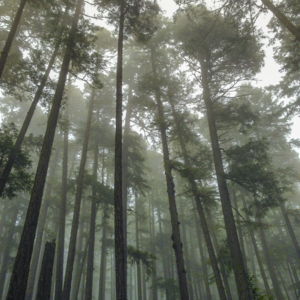
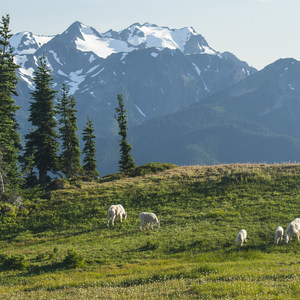
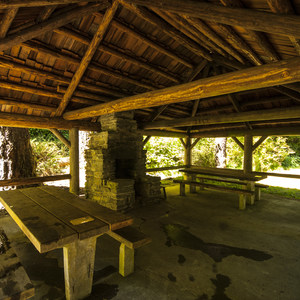
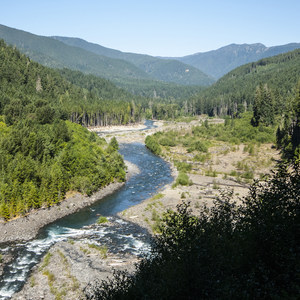
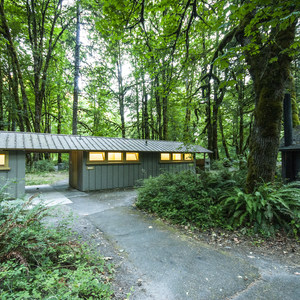



Comments
Sign In and share them.